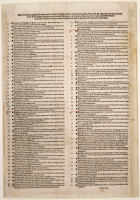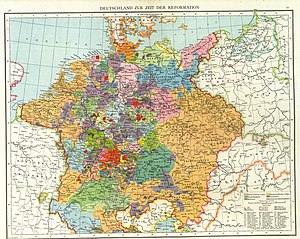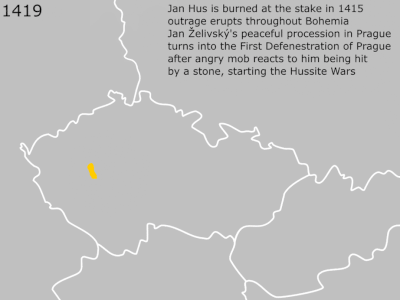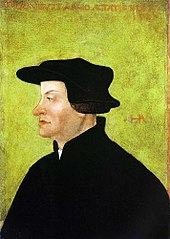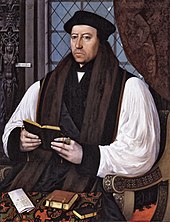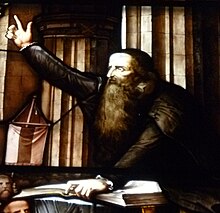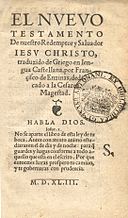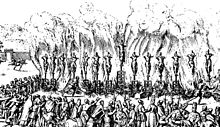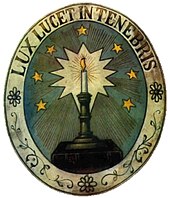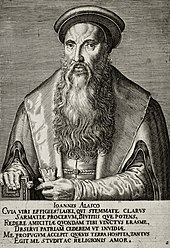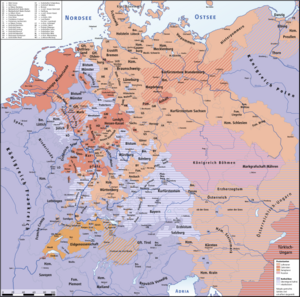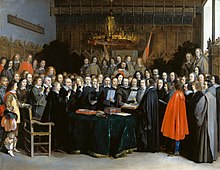Movements had been made towards a Reformation prior to Luther, so some Protestants in the tradition of the Radical Reformation prefer to credit the start of the Reformation to reformers such as Arnold of Brescia, Peter Waldo, Jan Hus, Tomáš Štítný ze Štítného, John Wycliffe, and Girolamo Savonarola. Due to the reform efforts of Hus and others in the Lands of the Bohemian Crown, Utraquist Hussitism was officially acknowledged by both the Pope and the Holy Roman Emperor, although other movements were still subject to persecution, as were the including Lollards in England and Waldensians in Italy and France.
Luther began by criticising the sale of indulgences, insisting that the Pope had no authority over purgatory and that the Treasury of Merit had no foundation in the Bible. The Reformation developed further to include a distinction between Law and Gospel, a complete reliance on Scripture as the only source of proper doctrine (sola scriptura) and the belief that faith in Jesus is the only way to receive God's pardon for sin (sola fide) rather than good works. Although this is generally considered a Protestant belief, a similar formulation was taught by Molinist and Jansenist Catholics. The priesthood of all believers downplayed the need for saints or priests to serve as mediators, and mandatory clerical celibacy was ended. Simul justus et peccator implied that although people could improve, no one could become good enough to earn forgiveness from God. Sacramental theology was simplified and attempts at imposing Aristotelian epistemology were resisted.
Luther and his followers did not see these theological developments as changes. The 1530 Augsburg Confession concluded that "in doctrine and ceremonies nothing has been received on our part against Scripture or the Church Catholic", and even after the Council of Trent, Martin Chemnitz published the 1565–73 Examination of the Council of Trent in order to prove that Trent innovated on doctrine while the Lutherans were following in the footsteps of the Church Fathers and Apostles.
The initial movement in Germany diversified, and other reformers arose independently of Luther such as Zwingli in Zürich and Calvin in Geneva. Depending on the country, the Reformation had varying causes and different backgrounds, and also unfolded differently than in Germany. The spread of Gutenberg's printing press provided the means for the rapid dissemination of religious materials in the vernacular.
During Reformation-era confessionalization, Western Christianity adopted different confessions (Catholic, Lutheran, Reformed, Anglican, Anabaptist, Unitarian, etc.). Radical Reformers, besides forming communities outside state sanction, sometimes employed more extreme doctrinal change, such as the rejection of the tenets of the councils of Nicaea and Chalcedon with the Unitarians of Transylvania. Anabaptist movements were especially persecuted following the German Peasants' War.
Leaders within the Roman Catholic Church responded with the Counter-Reformation, initiated by the Confutatio Augustana in 1530, the Council of Trent in 1545, the Jesuits in 1540, the Defensio Tridentinæ fidei in 1578, and also a series of wars and expulsions of Protestants that continued until the 19th century. Northern Europe, with the exception of most of Ireland, came under the influence of Protestantism. Southern Europe remained predominantly Catholic apart from the much-persecuted Waldensians. Central Europe was the site of much of the Thirty Years' War and there were continued expulsions of Protestants in central Europe up to the 19th century. Following World War II, the removal of ethnic Germans to either East Germany or Siberia reduced Protestantism in the Warsaw Pact countries, although some remain today. Absence of Protestants however, does not necessarily imply a failure of the Reformation. Although Protestants were excommunicated and ended up worshipping in communions separate from Catholics contrary to the original intention of the Reformers, they were also suppressed and persecuted in most of Europe at one point. As a result, some of them lived as crypto-Protestants, also called Nicodemites, contrary to the urging of John Calvin who wanted them to live their faith openly. Some crypto-Protestants have been identified as late as the 19th century after immigrating to Latin America. As a result Reformation impulses continued to affect the Latin Church well past the end of what is usually considered the Reformation era.
Luther began by criticising the sale of indulgences, insisting that the Pope had no authority over purgatory and that the Treasury of Merit had no foundation in the Bible. The Reformation developed further to include a distinction between Law and Gospel, a complete reliance on Scripture as the only source of proper doctrine (sola scriptura) and the belief that faith in Jesus is the only way to receive God's pardon for sin (sola fide) rather than good works. Although this is generally considered a Protestant belief, a similar formulation was taught by Molinist and Jansenist Catholics. The priesthood of all believers downplayed the need for saints or priests to serve as mediators, and mandatory clerical celibacy was ended. Simul justus et peccator implied that although people could improve, no one could become good enough to earn forgiveness from God. Sacramental theology was simplified and attempts at imposing Aristotelian epistemology were resisted.
Luther and his followers did not see these theological developments as changes. The 1530 Augsburg Confession concluded that "in doctrine and ceremonies nothing has been received on our part against Scripture or the Church Catholic", and even after the Council of Trent, Martin Chemnitz published the 1565–73 Examination of the Council of Trent in order to prove that Trent innovated on doctrine while the Lutherans were following in the footsteps of the Church Fathers and Apostles.
The initial movement in Germany diversified, and other reformers arose independently of Luther such as Zwingli in Zürich and Calvin in Geneva. Depending on the country, the Reformation had varying causes and different backgrounds, and also unfolded differently than in Germany. The spread of Gutenberg's printing press provided the means for the rapid dissemination of religious materials in the vernacular.
During Reformation-era confessionalization, Western Christianity adopted different confessions (Catholic, Lutheran, Reformed, Anglican, Anabaptist, Unitarian, etc.). Radical Reformers, besides forming communities outside state sanction, sometimes employed more extreme doctrinal change, such as the rejection of the tenets of the councils of Nicaea and Chalcedon with the Unitarians of Transylvania. Anabaptist movements were especially persecuted following the German Peasants' War.
Leaders within the Roman Catholic Church responded with the Counter-Reformation, initiated by the Confutatio Augustana in 1530, the Council of Trent in 1545, the Jesuits in 1540, the Defensio Tridentinæ fidei in 1578, and also a series of wars and expulsions of Protestants that continued until the 19th century. Northern Europe, with the exception of most of Ireland, came under the influence of Protestantism. Southern Europe remained predominantly Catholic apart from the much-persecuted Waldensians. Central Europe was the site of much of the Thirty Years' War and there were continued expulsions of Protestants in central Europe up to the 19th century. Following World War II, the removal of ethnic Germans to either East Germany or Siberia reduced Protestantism in the Warsaw Pact countries, although some remain today. Absence of Protestants however, does not necessarily imply a failure of the Reformation. Although Protestants were excommunicated and ended up worshipping in communions separate from Catholics contrary to the original intention of the Reformers, they were also suppressed and persecuted in most of Europe at one point. As a result, some of them lived as crypto-Protestants, also called Nicodemites, contrary to the urging of John Calvin who wanted them to live their faith openly. Some crypto-Protestants have been identified as late as the 19th century after immigrating to Latin America. As a result Reformation impulses continued to affect the Latin Church well past the end of what is usually considered the Reformation era.
Origins and early history
Earlier reform movements
Execution of Jan Hus in Konstanz (1415). Western Christianity was already formally compromised in the Lands of the Bohemian Crown long before Luther with the Basel Compacts (1436) and the Religious peace of Kutná Hora (1485). Utraquist Hussitism was allowed there alongside the Roman Catholic confession. By the time the Reformation arrived, the Kingdom of Bohemia and the Margraviate of Moravia both had majority Hussite populations for decades now.
The oldest Protestant churches, such as the Unitas Fratrum and Moravian Church, date their origins to Jan Hus
(John Huss) in the early 15th century. As it was led by a Bohemian
noble majority, and recognised, for a time, by the Basel Compacts, the
Hussite Reformation was Europe's first "Magisterial Reformation" because the ruling magistrates supported it, unlike the "Radical Reformation", which the state did not support.
Common factors that played a role during the Reformation and the Counter-Reformation included the rise of nationalism, simony, the appointment of Cardinal-nephews, and other corruption of the Roman Curia and other ecclesiastical hierarchy, the impact of humanism, the new learning of the Renaissance, the epistemological shift between the schola moderna and schola antiqua within scholasticism, and the Western Schism that eroded loyalty to the Papacy. Unrest due to the Great Schism of Western Christianity
(1378–1416) excited wars between princes, uprisings among the peasants,
and widespread concern over corruption in the Church, especially from John Wycliffe at Oxford University and from Jan Hus at the Charles University in Prague.
Hus objected to some of the practices of the Roman Catholic Church and wanted to return the church in Bohemia and Moravia to earlier practices: liturgy in the language of the people (i.e. Czech), having lay people receive communion in both kinds (bread and wine – that is, in Latin, communio sub utraque specie), married priests, and eliminating indulgences and the concept of Purgatory.
Some of these, like the use of local language as the lithurgic
language, were approved by the pope as early as in the 9th century. Hus rejected indulgences and adopted a doctrine of justification by grace through faith alone.
The leaders of the Roman Catholic Church condemned him at the Council of Constance (1414–1417) by burning him at the stake despite a promise of safe-conduct. Wycliffe was posthumously condemned as a heretic and his corpse exhumed and burned in 1428.
The Council of Constance confirmed and strengthened the traditional
medieval conception of church and empire. The council did not address
the national tensions or the theological tensions stirred up during the
previous century and could not prevent schism and the Hussite Wars in Bohemia.
Pope Sixtus IV
(1471–1484) established the practice of selling indulgences to be
applied to the dead, thereby establishing a new stream of revenue with
agents across Europe. Pope Alexander VI (1492–1503) was one of the most controversial of the Renaissance popes. He was the father of seven children, including Lucrezia and Cesare Borgia. In response to papal corruption, particularly the sale of indulgences, Luther wrote The Ninety-Five Theses.
A number of theologians in the Holy Roman Empire preached reformational ideas in the 1510s, shortly before or simultaneously with Luther, including Christoph Schappeler in Memmingen (as early as 1513).
Magisterial Reformation
Martin Luther initiated the Reformation with his Ninety-five Theses against the Catholic Church
Martin Luther at the Diet of Worms, where he refused to recant his works when asked to by Charles V. (painting from Anton von Werner, 1877, Staatsgalerie Stuttgart)
The Reformation is usually dated to 31 October 1517 in Wittenberg, Saxony, when Luther sent his Ninety-Five Theses on the Power and Efficacy of Indulgences to the Archbishop of Mainz.
The theses debated and criticised the Church and the papacy, but
concentrated upon the selling of indulgences and doctrinal policies
about purgatory, particular judgment, and the authority of the pope. He would later in the period 1517–1521 write works on devotion to Virgin Mary,
the intercession of and devotion to the saints, the sacraments,
mandatory clerical celibacy, further on the authority of the pope, the
ecclesiastical law, censure and excommunication, the role of secular
rulers in religious matters, the relationship between Christianity and
the law, good works, and monasticism. Some nuns left the monastic life when they accepted the Reformation, such as Katharina von Bora and Ursula of Munsterberg, but other orders adopted the Reformation, as Lutherans continue to have monasteries today. In contrast, Reformed areas typically secularized monastic property.
Reformers and their opponents made heavy use of inexpensive
pamphlets as well as vernacular Bibles using the relatively new printing
press, so there was swift movement of both ideas and documents. Magdalena Heymair printed pedagogical writings for teaching children Bible stories.
Parallel to events in Germany, a movement began in Switzerland under the leadership of Huldrych Zwingli.
These two movements quickly agreed on most issues, but some unresolved
differences kept them separate. Some followers of Zwingli believed that
the Reformation was too conservative, and moved independently toward
more radical positions, some of which survive among modern day Anabaptists.
After this first stage of the Reformation, following the excommunication of Luther in Decet Romanum Pontificem and the condemnation of his followers by the edicts of the 1521 Diet of Worms, the work and writings of John Calvin were influential in establishing a loose consensus among various churches in Switzerland, Scotland, Hungary, Germany and elsewhere.
Although the German Peasants' War of 1524–1525 began as a tax and anti-corruption protest as reflected in the Twelve Articles, its leader Thomas Müntzer gave it a radical Reformation character. It swept through the Bavarian, Thuringian and Swabian principalities, including the Black Company of Florian Geier, a knight from Giebelstadt who joined the peasants in the general outrage against the Catholic hierarchy.In response to reports about the destruction and violence, Luther condemned the revolt in writings such as Against the Murderous, Thieving Hordes of Peasants; Zwingli and Luther's ally Philipp Melanchthon also did not condone the uprising. Some 100,000 peasants were killed by the end of the war.
Radical Reformation
The Radical Reformation was the response to what was believed to be the corruption in both the Roman Catholic Church and the Magisterial
Reformation. Beginning in Germany and Switzerland in the 16th century,
the Radical Reformation developed radical Protestant churches throughout
Europe. The term includes Thomas Müntzer, Andreas Karlstadt, the Zwickau prophets, and Anabaptists like the Hutterites and Mennonites.
In parts of Germany, Switzerland and Austria, a majority sympathized with the Radical Reformation despite intense persecution. Although the surviving proportion of the European population that rebelled against Catholic, Lutheran and Zwinglian
churches was small, Radical Reformers wrote profusely and the
literature on the Radical Reformation is disproportionately large,
partly as a result of the proliferation of the Radical Reformation
teachings in the United States.
Despite significant diversity among the early Radical Reformers,
some “repeating patterns,” emerged among many Anabaptist groups. Many
of these patterns were enshrined in the Schleitheim Confession (1527), and include believers’ (or adult) baptism, memorial view of the Lord’s Supper, belief that Scripture is the final authority on matters of faith and practice, emphasis on the New Testament and the Sermon on the Mount, interpretation of Scripture in community, separation from the world and a two-kingdom theology, pacifism and nonresistance, communalism and economic sharing, belief in the freedom of the will, non-swearing of oaths, “yieldedness” (Gelassenheit) to one’s community and to God, the ban, salvation through divinization (Vergöttung) and ethical living, and discipleship (Nachfolge Christi).
Literacy
Martin Luther's 1534 Bible translated into German. Luther's translation influenced the development of the current Standard German.
The Reformation was a triumph of literacy and the new printing press. Luther's translation of the Bible
into German was a decisive moment in the spread of literacy, and
stimulated as well the printing and distribution of religious books and
pamphlets. From 1517 onward, religious pamphlets flooded Germany and
much of Europe.
By 1530, over 10,000 publications are known, with a total of ten
million copies. The Reformation was thus a media revolution. Luther
strengthened his attacks on Rome by depicting a "good" against "bad"
church. From there, it became clear that print could be used for
propaganda in the Reformation for particular agendas, although the term
propaganda derives from the Catholic Congregatio de Propaganda Fide (Congregation for Propagating the Faith) from the Counter-Reformation. Reform writers used existing styles, clichés and stereotypes which they adapted as needed. Especially effective were writings in German, including Luther's translation of the Bible, his Smaller Catechism for parents teaching their children, and his Larger Catechism, for pastors.
Using the German vernacular they expressed the Apostles' Creed in
simpler, more personal, Trinitarian language. Illustrations in the
German Bible and in many tracts popularised Luther's ideas. Lucas Cranach the Elder
(1472–1553), the great painter patronised by the electors of
Wittenberg, was a close friend of Luther, and he illustrated Luther's
theology for a popular audience. He dramatised Luther's views on the
relationship between the Old and New Testaments, while remaining mindful
of Luther's careful distinctions about proper and improper uses of
visual imagery.
Causes of the Reformation
Erasmus was a Catholic priest who inspired some of the Protestant reformers.
The following supply-side factors have been identified as causes of the Reformation:
- The presence of a printing press in a city by 1500 made Protestant adoption by 1600 far more likely.
- Protestant literature was produced at greater levels in cities where media markets were more competitive, making these cities more likely to adopt Protestantism.
- Ottoman incursions decreased conflicts between Protestants and Catholics, helping the Reformation take root.
- Greater political autonomy increased the likelihood that Protestantism would be adopted.
- Where Protestant reformers enjoyed princely patronage, they were much more likely to succeed.
- Proximity to neighbors who adopted Protestantism increased the likelihood of adopting Protestantism.
- Cities that had higher numbers of students enrolled in heterodox universities and lower numbers enrolled in orthodox universities were more likely to adopt Protestantism.
The following demand-side factors have been identified as causes of the Reformation:
- Cities with strong cults of saints were less likely to adopt Protestantism.
- Cities where primogeniture was practiced were less likely to adopt Protestantism.
- Regions that were poor but had great economic potential and bad political institutions were more likely to adopt Protestantism.
- The presence of bishoprics made the adoption of Protestantism less likely.
- The presence of monasteries made the adoption of Protestantism less likely.
Reformation in Germany
In 1517, Luther nailed the Ninety-five theses to the Castle
Church door, and without his knowledge or prior approval, they were
copied and printed across Germany and internationally. Different
reformers arose more or less independently of Luther in 1518 (for
example Andreas Karlstadt, Philip Melanchthon, Erhard Schnepf, Johannes Brenz and Martin Bucer), 1519 (for example Huldrych Zwingli, Nikolaus von Amsdorf, Ulrich von Hutten) and so on.
After the Heidelberg Disputation (1518) where Luther described the Theology of the Cross as opposed to the Theology of Glory and the Leipzig Disputation
(1519), the faith issues were brought to the attention of other German
theologians throughout the Empire. Each year drew new theologians to
embrace the Reformation and participate in the ongoing, European-wide
discussion about faith. The pace of the Reformation proved unstoppable
already by 1520.
The early Reformation in Germany mostly concerns the life of
Martin Luther until he was excommunicated by Pope Leo X on 3 January
1521, in the bull Decet Romanum Pontificem. The exact moment Martin Luther realized the key doctrine of Justification by Faith is described in German as the Turmerlebnis. In Table Talk, Luther describes it as a sudden realization. Experts often speak of a gradual process of realization between 1514 and 1518.
Reformational ideas and Protestant church services were first
introduced in cities, being supported by local citizens and also some
nobles. The Reformation did not receive overt state support until 1525,
although it was only due to the protection of Elector Frederick the Wise who had a strange dream the night prior to October 31st 1517 that Luther survived after being declared an outlaw, both in hiding at Wartburg Castle and afterward his return to Wittenberg.
It was more of a movement among the German people between 1517 and
1525, and then also a political one beginning in 1525. Reformer Adolf Clarenbach was burned at the stake near Cologne in 1529.
The first state to formally adopt a Protestant confession was the Duchy of Prussia (1525). Albert, Duke of Prussia formally declared the "Evangelical" faith to be the state religion. Catholics labeled
self-identified Evangelicals "Lutherans" in order to discredit them
after the practice of naming a heresy after its founder. Ducal Prussia
was followed by many imperial free cities and other minor imperial entities. The next sizeable territories were the Landgraviate of Hesse (1526; at the Synod of Homberg) and the Electorate of Saxony (1527; Luther's homeland), Electoral Palatinate (1530s) and the Duchy of Württemberg (1534). For a more complete list, see the list of states by the date of adoption of the Reformation and the table of the adoption years for the Augsburg Confession. The reformational wave swept first the Holy Roman Empire, and then extended beyond it to the rest of the European continent.
Germany was home to the greatest number of Protestant reformers. Each state which turned Protestant had their own reformers who contributed towards the Evangelical faith. In Electoral Saxony the Evangelical-Lutheran Church of Saxony was organized and served as an example for other states, although Luther was not dogmatic on questions of polity.
Reformation outside Germany
The Reformation also spread widely throughout Europe, starting with
Bohemia, in the Czech lands, and, over the next few decades, to other
countries.
Austria
Austria followed the same pattern of the German-speaking states within the Holy Roman Empire, and Lutheranism became the main Protestant confession among its population. Lutheranism gained a significant following in Austria which was concentrated in the eastern half of present-day Austria, while Calvinism was less successful. Eventually the expulsions of the Counter-Reformation reversed the trend.
Evolution of the Hussite movement in the Lands of the Bohemian Crown from 1419 to 1620, superimposed on modern borders
Czech Lands
The Hussites were a Christian movement in the Kingdom of Bohemia following the teachings of Czech reformer Jan Hus.
Jan Hus
Czech reformer and university professor Jan Hus
(c. 1369–1415) became the best-known representative of the Bohemian
Reformation and one of the forerunners of the Protestant Reformation.
Jan Hus was declared heretic and executed – burned at stake – at the Council of Constance in 1415 where he arrived voluntarily to defend his teachings.
Hussite movement
This predominantly religious movement was propelled by social issues
and strengthened Czech national awareness. In 1417, two years after the
execution of Jan Hus, the Czech reformation quickly became the chief
force in the country.
Jiří Třanovský (1592–1637), the "Luther of the Slavs" who was active in Bohemia, Moravia, and Poland
Hussites
made up the vast majority of the population, forcing the Council of
Basel to recognize in 1437 a system of two "religions" for the first
time signing the Compacts of Basel for the kingdom (Catholic and Czech Ultraquism, a Hussite movement). Bohemia later also elected two Protestant kings (George of Poděbrady).
After Habsburgs took control of the region, the Hussite churches were prohibited and the kingdom partially recatholicized. Even later Lutheranism
gained a substantial following, after being permitted by the Habsburgs
with the continued persecution of the Czech native Hussite churches.
Many Hussites thus declared themselves Lutherans.
Two churches with Hussite roots are now second and third biggest churches in the predominantly agnostic country: Czech Brethren (which gave origin to the international church known as the Moravian Church) and Czechoslovak Hussite Church.
Switzerland
In Switzerland, the teachings of the reformers and especially those
of Zwingli and Calvin had a profound effect, despite the frequent
quarrels between the different branches of the Reformation.
Huldrych Zwingli
Huldrych Zwingli launched the Reformation in Switzerland. Portrait by Hans Asper.
Parallel to events in Germany, a movement began in the Swiss Confederation under the leadership of Huldrych Zwingli. Zwingli was a scholar and preacher who moved to Zurich – the then-leading city state – in 1518, a year after Martin Luther began the Reformation in Germany with his Ninety-five Theses. Although the two movements agreed on many issues of theology, as the recently introduced printing press
spread ideas rapidly from place to place, some unresolved differences
kept them separate. Long-standing resentment between the German states
and the Swiss Confederation led to heated debate over how much Zwingli
owed his ideas to Lutheranism. Although Zwinglianism
does hold uncanny resemblance to Lutheranism (it even had its own
equivalent of the Ninety-five Theses, called the 67 Conclusions),
historians have been unable to prove that Zwingli had any contact with
Luther's publications before 1520, and Zwingli himself maintained that
he had prevented himself from reading them.
The German Prince Philip of Hesse
saw potential in creating an alliance between Zwingli and Luther,
seeing strength in a united Protestant front. A meeting was held in his
castle in 1529, now known as the Colloquy of Marburg,
which has become infamous for its complete failure. The two men could
not come to any agreement due to their disputation over one key
doctrine. Although Luther preached consubstantiation in the Eucharist over transubstantiation, he believed in the real presence of Christ at the Mass. Zwingli, inspired by Dutch theologian Cornelius Hoen, believed that the mass was only representative and memorial – Christ was not present. Luther became so angry that he famously carved into the meeting table in chalk Hoc Est Corpus Meum – a Biblical quotation from the Last Supper meaning 'This is my body'. Zwingli countered this saying that est in that context was the equivalent of the word significant (signifies).
Some followers of Zwingli believed that the Reformation was too
conservative and moved independently toward more radical positions, some
of which survive among modern day Anabaptists.
One famous incident illustrating this was when radical Zwinglians fried
and ate sausages during Lent in Zurich city square by way of protest
against the Church teaching of good works. Other Protestant movements grew up along the lines of mysticism or humanism (cf. Erasmus and Louis de Berquin who was martyred in 1529), sometimes breaking from Rome or from the Protestants, or forming outside of the churches.
John Calvin
John Calvin was one of the leading figures of the Reformation. His legacy remains in a variety of churches.
Following the excommunication
of Luther and condemnation of the Reformation by the Pope, the work and
writings of John Calvin were influential in establishing a loose
consensus among various churches in Switzerland, Scotland,
Hungary, Germany and elsewhere. After the expulsion of its Bishop in
1526, and the unsuccessful attempts of the Berne reformer Guillaume (William) Farel,
Calvin was asked to use the organisational skill he had gathered as a
student of law to discipline the "fallen city" of Geneva. His
"Ordinances" of 1541 involved a collaboration of Church affairs with the
City council and consistory
to bring morality to all areas of life. After the establishment of the
Geneva academy in 1559, Geneva became the unofficial capital of the
Protestant movement, providing refuge for Protestant exiles from all
over Europe and educating them as Calvinist missionaries. These
missionaries dispersed Calvinism widely, and formed the French Huguenots in Calvin's own lifetime and spread to Scotland under the leadership of the cantankerous John Knox in 1560. Anne Locke
translated some of Calvin's writings to English around this time. The
faith continued to spread after Calvin's death in 1563 and reached as
far as Constantinople by the start of the 17th century.
The Reformation foundations engaged with Augustinianism. Both Luther and Calvin thought along lines linked with the theological teachings of Augustine of Hippo. The Augustinianism of the Reformers struggled against Pelagianism,
a heresy that they perceived in the Catholic Church of their day.
Ultimately, since Calvin and Luther disagreed strongly on certain
matters of theology (such as double-predestination and Holy Communion),
the relationship between Lutherans and Calvinists was one of conflict.
Nordic countries
The seal of the Diocese of Turku
(Finland) during the 16th and 17th centuries featured the finger of St
Henry. The post-Reformation diocese included the relic of a
pre-Reformation saint in its seal.
All of Scandinavia ultimately adopted Lutheranism over the course of the 16th century, as the monarchs of Denmark (who also ruled Norway and Iceland) and Sweden (who also ruled Finland) converted to that faith.
Sweden
In Sweden, the Reformation was spearheaded by Gustav Vasa,
elected king in 1523. Friction with the pope over the latter's
interference in Swedish ecclesiastical affairs led to the discontinuance
of any official connection between Sweden and the papacy from 1523.
Four years later, at the Diet of Västerås, the king succeeded in forcing
the diet to accept his dominion over the national church. The king was
given possession of all church property, church appointments required
royal approval, the clergy were subject to the civil law, and the "pure
Word of God" was to be preached in the churches and taught in the
schools – effectively granting official sanction to Lutheran ideas. The apostolic succession#Lutheran churches was retained in Sweden during the Reformation.
Denmark
Under the reign of Frederick I
(1523–33), Denmark remained officially Catholic. But though Frederick
initially pledged to persecute Lutherans, he soon adopted a policy of
protecting Lutheran preachers and reformers, of whom the most famous was
Hans Tausen.
During his reign, Lutheranism made significant inroads among the Danish
population. Frederick's son, Christian, was openly Lutheran, which
prevented his election to the throne upon his father's death. In 1536,
the authority of the Catholic bishops was terminated by national
assembly. The next year, following his victory in the Count's War, he became king as Christian III and continued the Reformation of the state church with assistance of Johannes Bugenhagen.
Iceland
Luther's influence had already reached Iceland before King Christian's decree. The Germans fished near Iceland's coast, and the Hanseatic League engaged in commerce with the Icelanders. These Germans raised a Lutheran church in Hafnarfjörður as early as 1533. Through German trade connections, many young Icelanders studied in Hamburg. In 1538, when the kingly decree of the new Church ordinance reached Iceland, bishop Ögmundur and his clergy denounced it, threatening excommunication for anyone subscribing to the German 'heresy'. In 1539, the King sent a new governor to Iceland, Klaus von Mervitz, with a mandate to introduce reform and take possession of church property. Von Mervitz seized a monastery in Viðey with the help of his sheriff, Dietrich of Minden,
and his soldiers. They drove the monks out and seized all their
possessions, for which they were promptly excommunicated by Ögmundur.
England
Church of England
Henry VIII broke England's ties with the Roman Catholic Church, becoming the sole head of the English Church.
The separation of the Church of England from Rome under Henry VIII, beginning in 1529 and completed in 1537 brought England alongside this broad Reformation movement. Although Robert Barnes
attempted to get Henry VIII to adopt Lutheran theology, he refused to
do so in 1538 and burned him at the stake in 1540. Reformers in the
Church of England alternated, for decades, between sympathies between
Catholic tradition and Reformed principles, gradually developing within
the context of robustly Protestant doctrine, a tradition considered a
middle way (via media) between the Catholic and Protestant traditions.
The English Reformation followed a different course from the
Reformation in continental Europe. There had long been a strong strain
of anti-clericalism. England had already given rise to the Lollard movement of John Wycliffe, which played an important part in inspiring the Hussites in Bohemia.
Lollardy was suppressed and became an underground movement, so the
extent of its influence in the 1520s is difficult to assess. The
different character of the English Reformation came rather from the fact
that it was driven initially by the political necessities of Henry
VIII.
Henry had once been a sincere Catholic and had even authored a book strongly criticising Luther. His wife, Catherine of Aragon, bore him only a single child that survived infancy, Mary.
Henry strongly wanted a male heir, and many of his subjects might have
agreed, if only because they wanted to avoid another dynastic conflict
like the Wars of the Roses.
Thomas Cranmer proved essential in the development of the English Reformation.
King Henry decided to remove the Church of England from the authority of Rome. In 1534, the Act of Supremacy recognized Henry as "the only Supreme Head on earth of the Church of England". Between 1535 and 1540, under Thomas Cromwell, the policy known as the Dissolution of the Monasteries was put into effect. The veneration of some saints,
certain pilgrimages and some pilgrim shrines were also attacked. Huge
amounts of church land and property passed into the hands of the Crown
and ultimately into those of the nobility and gentry. The vested
interest thus created made for a powerful force in support of the
dissolutions.
There were some notable opponents to the Henrician Reformation, such as Thomas More and Cardinal John Fisher,
who were executed for their opposition. There was also a growing party
of reformers who were imbued with the Calvinistic, Lutheran and
Zwinglian doctrines now current on the Continent. When Henry died he was
succeeded by his Protestant son Edward VI,
who, through his empowered councillors (with the King being only nine
years old at his succession and fifteen at his death) the Duke of
Somerset and the Duke of Northumberland, ordered the destruction of
images in churches, and the closing of the chantries. Under Edward VI the Church of England moved closer to continental Protestantism.
Yet, at a popular level, religion in England was still in a state
of flux. Following a brief Catholic restoration during the reign of
Mary (1553–1558), a loose consensus developed during the reign of Elizabeth I, though this point is one of considerable debate among historians. This "Elizabethan Religious Settlement" largely formed Anglicanism into a distinctive church tradition. The compromise was uneasy and was capable of veering between extreme Calvinism
on one hand and Catholicism on the other. But compared to the bloody
and chaotic state of affairs in contemporary France, it was relatively
successful, in part because Queen Elizabeth lived so long, until the
Puritan Revolution or English Civil War in the 17th century.
English dissenters
Oliver Cromwell was a devout Puritan and military leader, who became Lord Protector of England, Scotland, and Ireland.
The success of the Counter-Reformation on the Continent and the growth of a Puritan party dedicated to further Protestant reform polarised the Elizabethan Age,
although it was not until the 1640s that England underwent religious
strife comparable to what its neighbours had suffered some generations
before.
The early Puritan movement (late 16th–17th centuries) was Reformed (or Calvinist) and was a movement for reform in the Church of England. Its origins lay in the discontent with the Elizabethan Religious Settlement. The desire was for the Church of England to resemble more closely the Protestant churches of Europe, especially Geneva. The Puritans objected to ornaments and ritual in the churches as idolatrous (vestments, surplices, organs, genuflection), which they castigated as "popish pomp and rags".
They also objected to ecclesiastical courts. Their refusal to endorse
completely all of the ritual directions and formulas of the Book of Common Prayer
and the imposition of its liturgical order by legal force and
inspection sharpened Puritanism into a definite opposition movement.
The later Puritan movement, often referred to as dissenters and nonconformists, eventually led to the formation of various reformed denominations.
The most famous emigration to America was the migration of
Puritan separatists from the Anglican Church of England. They fled first
to Holland, and then later to America to establish the English colony of Massachusetts in New England, which later became one of the original United States. These Puritan separatists were also known as "the Pilgrims". After establishing a colony at Plymouth (which became part of the colony of Massachusetts) in 1620, the Puritan pilgrims received a charter from the King of England
that legitimised their colony, allowing them to do trade and commerce
with merchants in England, in accordance with the principles of mercantilism. The Puritans persecuted those of other religious faiths, for example, Anne Hutchinson was banished to Rhode Island during the Antinomian Controversy. Quaker Mary Dyer was hanged in Boston for repeatedly defying a Puritan law banning Quakers from the colony. She was one of the four executed Quakers known as the Boston martyrs. Executions ceased in 1661 when King Charles II explicitly forbade Massachusetts from executing anyone for professing Quakerism. In 1647, Massachusetts passed a law prohibiting any Jesuit Roman Catholic priests from entering territory under Puritan jurisdiction. Any suspected person who could not clear himself was to be banished from the colony; a second offense carried a death penalty.
The Pilgrims held radical Protestant disapproval of Christmas, and its celebration was outlawed in Boston from 1659 to 1681. The ban was revoked in 1681 by the English-appointed governor Edmund Andros, who also revoked a Puritan ban on festivities on Saturday nights. Nevertheless, it was not until the mid-19th century that celebrating Christmas became fashionable in the Boston region.
Wales
Bishop Richard Davies and dissident Protestant cleric John Penry introduced Calvinist theology to Wales. In 1588, the Bishop of Llandaff published the entire Bible in the Welsh language. The translation had a significant impact upon the Welsh population and helped to firmly establish Protestantism among the Welsh people.
The Welsh Protestants used the model of the Synod of Dort
of 1618–1619. Calvinism developed through the Puritan period, following
the restoration of the monarchy under Charles II, and within Wales' Calvinistic Methodist movement. However few copies of Calvin's writings were available before mid-19th century.
Scotland
John Knox was a leading figure in the Scottish Reformation.
The Reformation in Scotland's case culminated ecclesiastically in the establishment of a church along reformed lines, and politically in the triumph of English influence over that of France. John Knox is regarded as the leader of the Scottish reformation.
The Reformation Parliament of 1560 repudiated the pope's authority by the Papal Jurisdiction Act 1560, forbade the celebration of the Mass and approved a Protestant Confession of Faith. It was made possible by a revolution against French hegemony under the regime of the regent Mary of Guise, who had governed Scotland in the name of her absent daughter Mary, Queen of Scots (then also Queen of France).
Although Protestantism triumphed relatively easily in Scotland,
the exact form of Protestantism remained to be determined. The 17th
century saw a complex struggle between Presbyterianism (particularly the Covenanters) and Episcopalianism. The Presbyterians eventually won control of the Church of Scotland, which went on to have an important influence on Presbyterian churches worldwide, but Scotland retained a relatively large Episcopalian minority.
France
Although a Catholic clergyman himself, Cardinal Richelieu allied France with Protestant states.
Besides the Waldensians already present in France, Protestantism also
spread in from German lands, where the Protestants were nicknamed Huguenots; this eventually led to decades of civil warfare.
Though not personally interested in religious reform, Francis I (reigned 1515–1547) initially maintained an attitude of tolerance, in accordance with his interest in the humanist movement. This changed in 1534 with the Affair of the Placards. In this act, Protestants denounced the Catholic Mass
in placards that appeared across France, even reaching the royal
apartments. During this time as the issue of religious faith entered
into the arena of politics, Francis came to view the movement as a
threat to the kingdom's stability.
Following the Affair of the Placards, culprits were rounded up,
at least a dozen heretics were put to death, and the persecution of
Protestants increased.
One of those who fled France at that time was John Calvin, who
emigrated to Basel in 1535 before eventually settling in Geneva in 1536.
Beyond the reach of the French kings in Geneva, Calvin continued to
take an interest in the religious affairs of his native land including
the training of ministers for congregations in France.
As the number of Protestants in France increased, the number of
heretics in prisons awaiting trial also grew. As an experimental
approach to reduce the caseload in Normandy, a special court just for
the trial of heretics was established in 1545 in the Parlement de Rouen. When Henry II
took the throne in 1547, the persecution of Protestants grew and
special courts for the trial of heretics were also established in the
Parlement de Paris. These courts came to known as "La Chambre Ardente" ("the fiery chamber") because of their reputation of meting out death penalties on burning gallows.
Despite heavy persecution by Henry II, the Reformed Church of France, largely Calvinist in direction, made steady progress across large sections of the nation, in the urban bourgeoisie and parts of the aristocracy, appealing to people alienated by the obduracy and the complacency of the Catholic establishment.
Saint Bartholomew's Day massacre, painting by François Dubois
French Protestantism, though its appeal increased under persecution,
came to acquire a distinctly political character, made all the more
obvious by the conversions of nobles during the 1550s. This established
the preconditions for a series of destructive and intermittent
conflicts, known as the Wars of Religion. The civil wars gained impetus with the sudden death of Henry II in 1559, which began a prolonged period of weakness for the French crown. Atrocity and outrage became the defining characteristics of the time, illustrated at their most intense in the St. Bartholomew's Day massacre
of August 1572, when the Catholic party killed between 30,000 and
100,000 Huguenots across France. The wars only concluded when Henry IV, himself a former Huguenot, issued the Edict of Nantes
(1598), promising official toleration of the Protestant minority, but
under highly restricted conditions. Catholicism remained the official
state religion, and the fortunes of French Protestants gradually
declined over the next century, culminating in Louis XIV's Edict of Fontainebleau
(1685), which revoked the Edict of Nantes and made Catholicism the sole
legal religion of France, leading some Huguenots to live as Nicodemites. In response to the Edict of Fontainebleau, Frederick William I, Elector of Brandenburg declared the Edict of Potsdam (October 1685), giving free passage to Huguenot refugees and tax-free status to them for ten years.
In the late 17th century, 150,000–200,000 Huguenots fled to
England, the Netherlands, Prussia, Switzerland, and the English and
Dutch overseas colonies. A significant community in France remained in the Cévennes region. A separate Protestant community, of the Lutheran faith, existed in the newly conquered (1639– ) province of Alsace, its status not affected by the Edict of Fontainebleau.
Spain
The New Testament translated by Joanes Leizarraga into the Basque language (1571) on the orders of Navarre's Calvinist queen, Jeanne III of Navarre
In the early 16th century, Spain had a different political and
cultural milieu from its Western and Central European neighbors in
several respects, which affected the mentality and the reaction of the
nation towards the Reformation. Spain, which had only recently managed
to complete the reconquest of the Peninsula from the Moors
in 1492, had been preoccupied with converting the Muslim and Jewish
population of the newly conquered regions through the establishment of
the Spanish Inquisition
in 1478. The rulers of the nation stressed political, cultural, and
religious unity, and by the time of the Lutheran Reformation, the
Spanish Inquisition was already 40 years old and had the capability of
quickly persecuting with any new movement that the leaders of the
Catholic Church perceived or interpreted to be religious heterodoxy. Charles V
did not wish to see Spain or the rest of Habsburg Europe divided, and
in light of continual threat from the Ottomans, preferred to see the
Roman Catholic Church reform itself from within. This led to a Counter-Reformation
in Spain in the 1530s. During the 1520s, the Spanish Inquisition had
created an atmosphere of suspicion and sought to root out any religious
thought seen as suspicious. As early as 1521, the Pope had written a
letter to the Spanish monarchy warning against allowing the unrest in
Northern Europe to be replicated in Spain. Between 1520 and 1550,
printing presses in Spain were tightly controlled and any books of
Protestant teaching were prohibited.
Contemporary illustration of the auto-da-fé of Valladolid, in which fourteen Protestants were burned at the stake for their faith, on May 21, 1559
Between 1530 and 1540, Protestantism in Spain was still able to gain followers clandestinely, and in cities such as Seville and Valladolid adherents would secretly meet at private houses to pray and study the Bible.
Protestants in Spain were estimated at between 1000 and 3000, mainly
among intellectuals who had seen writings such as those of Erasmus. Notable reformers included Dr. Juan Gil and Juan Pérez de Pineda who subsequently fled and worked alongside others such as Francisco de Enzinas to translate the Greek New Testament
into the Spanish language, a task completed by 1556. Protestant
teachings were smuggled into Spain by Spaniards such as Julián
Hernández, who in 1557 was condemned by the Inquisition and burnt at the
stake. Under Philip II,
conservatives in the Spanish church tightened their grip, and those who
refused to recant such as Rodrigo de Valer were condemned to life
imprisonment. In May 1559, sixteen Spanish Lutherans were burnt at the
stake: fourteen were strangled before being burnt, while two were burnt
alive. In October another thirty were executed. Spanish Protestants who
were able to flee the country were to be found in at least a dozen
cities in Europe, such as Geneva, where some of them embraced Calvinist teachings. Those who fled to England were given support by the Church of England.
The Kingdom of Navarre, although by the time of the Protestant Reformation a minor principality territorially restricted to southern France, had French Huguenot monarchs, including Henry IV of France and his mother, Jeanne III of Navarre, a devout Calvinist.
Upon the arrival of the Protestant Reformation, Calvinism reached some Basques through the translation of the Bible into the Basque language by Joanes Leizarraga. As Queen of Navarre, Jeanne III commissioned the translation of the New Testament into Basque and Béarnese for the benefit of her subjects.
Molinism presented a soteriology similar to Protestants within the Roman Catholic Church.
Portugal
During the Reformation era Protestantism was unsuccessful in
Portugal, as its spread was frustrated for similar reasons to those in
Spain.
Netherlands
Anabaptist Dirk Willems rescues his pursuer and is subsequently burned at the stake in 1569.
The Reformation in the Netherlands, unlike in many other countries, was not initiated by the rulers of the Seventeen Provinces,
but instead by multiple popular movements, which in turn were bolstered
by the arrival of Protestant refugees from other parts of the
continent. While the Anabaptist movement enjoyed popularity in the region in the early decades of the Reformation, Calvinism, in the form of the Dutch Reformed Church, became the dominant Protestant faith in the country from the 1560s onward. In the early 17th century internal theological conflict within the Calvinist church between two tendencies of Calvinism, the Gomarists and the liberal Arminians (or Remonstrants), resulted in Gomarist Calvinism becoming the de facto state religion.
Belgium
The first two Lutheran martyrs were monks from Antwerp, Johann Esch and Heinrich Voes who were burned at the stake when they would not recant.
Harsh persecution of Protestants by the Spanish government of Philip II contributed to a desire for independence in the provinces, which led to the Eighty Years' War and, eventually, the separation of the largely Protestant Dutch Republic from the Catholic-dominated Southern Netherlands (present-day Belgium).
In 1566, at the peak of Belgian Reformation, there were an estimated 300,000 Protestants, or 20% of the Belgian population.
Luxembourg
Luxembourg, a part of the Spanish Netherlands, remained Catholic during the Reformation era because Protestantism was illegal until 1768.
Hungary
Stephen Bocskay prevented the Holy Roman Emperor from imposing Catholicism on Hungarians.
Much of the population of the Kingdom of Hungary adopted Protestantism during the 16th century. After the 1526 Battle of Mohács,
the Hungarian people were disillusioned by the inability of the
government to protect them and turned to the faith they felt would
infuse them with the strength necessary to resist the invader. They
found this in the teaching of Protestant reformers such as Martin Luther.
The spread of Protestantism in the country was assisted by its large
ethnic German minority, which could understand and translate the writings of Martin Luther. While Lutheranism gained a foothold among the German- and Slovak-speaking populations, Calvinism became widely accepted among ethnic Hungarians.
In the more independent northwest, the rulers and priests, protected now by the Habsburg Monarchy,
which had taken the field to fight the Turks, defended the old Catholic
faith. They dragged the Protestants to prison and the stake wherever
they could. Such strong measures only fanned the flames of protest,
however. Leaders of the Protestants included Mátyás Dévai Bíró, Mihály Sztárai, István Szegedi Kis, and Ferenc Dávid.
Protestants likely formed a majority of Hungary's population at the close of the 16th century, but Counter-Reformation
efforts in the 17th century reconverted a majority of the kingdom to
Catholicism. A significant Protestant minority remained, most of it
adhering to the Calvinist faith.
In 1558 the Transylvanian Diet of Turda decreed the free practice of both the Catholic and Lutheran religions, but prohibited Calvinism.
Ten years later, in 1568, the Diet extended this freedom, declaring
that "It is not allowed to anybody to intimidate anybody with captivity
or expulsion for his religion". Four religions were declared to be
"accepted" (recepta) religions (the fourth being Unitarianism, which became official in 1583 as the faith of the only Unitarian king, John II Sigismund Zápolya, r. 1540–1571), while Eastern Orthodox Christianity was "tolerated" (though the building of stone Orthodox churches was forbidden). During the Thirty Years' War, Royal (Habsburg) Hungary joined the Catholic side, until Transylvania joined the Protestant side.
Between 1604 and 1711, there was a series of anti-Habsburg
uprisings calling for equal rights and freedom for all Christian
denominations, with varying success; the uprisings were usually
organised from Transylvania. The Habsburg-sanctioned Counter-Reformation
efforts in the 17th century reconverted the majority of the kingdom to
Catholicism.
The centre of Protestant learning in Hungary has for some centuries been the University of Debrecen.
Founded in 1538, the University was situated in an area of Eastern
Hungary under Ottoman Turkish rule during the 1600s and 1700s, being
allowed Islamic toleration and thus avoiding Counter-Reformation
persecution.
Romania
Transylvania in what is today's Romania was a "dumping ground for undesirables" by the Habsburg monarchy. People who did not conform to the will of the Habsburgs and the leaders of the Catholic Church were forcibly sent there. Centuries of this practice allowed diverse Protestant traditions to emerge in Romania, including Lutheranism, Calvinism and Unitarianism.
Ukraine
Calvinism was popular among Hungarians who inhabited the southwestern parts of the present-day Ukraine. Their descendants are still there, see the Sub-Carpathian Reformed Church.
Belarus
The first Protestant congregation was founded in Brest-Litovsk in the Reformed tradition, and the Belarusian Evangelical Reformed Church exists today.
Ireland
A devout Catholic, Mary I of England started the first Plantations of Ireland, which, ironically, soon came to be associated with Protestantism.
The Reformation in Ireland was a movement for the reform of religious
life and institutions that was introduced into Ireland by the English
administration at the behest of King Henry VIII of England. His desire
for an annulment of his marriage was known as the King's Great Matter. Ultimately Pope Clement VII
refused the petition; consequently it became necessary for the King to
assert his lordship over the church in his realm to give legal effect to
his wishes. The English Parliament confirmed the King's supremacy over the Church in the Kingdom of England. This challenge to Papal supremacy resulted in a breach with the Roman Catholic Church. By 1541, the Irish Parliament had agreed to the change in status of the country from that of a Lordship to that of Kingdom of Ireland.
Unlike similar movements for religious reform on the continent of
Europe, the various phases of the English Reformation as it developed
in Ireland were largely driven by changes in government policy, to which
public opinion in England gradually accommodated itself. However, a
number of factors complicated the adoption of the religious innovations
in Ireland; the majority of the population there adhered to the Catholic
Church. However, in the city of Dublin the reformation took hold under the auspices of George Browne.
Italy
Waldensian symbol Lux lucet in tenebris ("Light glows in the darkness")
Word of the Protestant reformers reached Italy in the 1520s but never
caught on. Its development was stopped by the Counter-Reformation, the
Inquisition and also popular disinterest. Not only was the Church highly
aggressive in seeking out and suppressing heresy, but there was a
shortage of Protestant leadership. No one translated the Bible into
Italian; few tracts were written. No core of Protestantism emerged. The
few preachers who did take an interest in "Lutheranism", as it was
called in Italy, were suppressed or went into exile to northern
countries where their message was well received. As a result, the
Reformation exerted almost no lasting influence in Italy, except for
strengthening the Catholic Church and pushing for an end to ongoing
abuses in Counter-Reformation.
Some Protestants left Italy and became outstanding activists of the European Reformation, mainly in the Polish–Lithuanian Commonwealth (e.g. Giorgio Biandrata, Bernardino Ochino, Giovanni Alciato, Giovanni Battista Cetis, Fausto Sozzini, Francesco Stancaro and Giovanni Valentino Gentile), who propagated Nontrinitarianism there and were chief instigators of the movement of Polish Brethren. Some also fled to England and Switzerland, including Peter Vermigli.
In 1532, the Waldensians, who had been already present centuries before the Reformation, aligned themselves and adopted the Calvinist theology. The Waldensian Church survived in the Western Alps through many persecutions and remains a Protestant church in Italy.
Poland and Lithuania
Jan Łaski sought unity between various Christian churches in the Commonwealth, and participated in the English Reformation.
In the first half of the 16th century, the enormous Polish–Lithuanian Commonwealth
was a country of many creeds, but Catholicism remained the dominating
religion. Reformation reached Poland in the 1520s and quickly gained
popularity among mostly German-speaking inhabitants of such major cities
as Danzig (now Gdańsk), Thorn (now Toruń) and Elbing (now Elbląg). In Königsberg (now Kaliningrad), in 1530, a Polish-language edition of Luther's Small Catechism was published. The Duchy of Prussia, which was a Polish fief,
emerged as a key center of the movement, with numerous publishing
houses issuing not only Bibles, but also catechisms, in German, Polish
and Lithuanian.
Lutheranism gained popularity in the northern part of the country, while Calvinism caught the interest of the nobility (known as szlachta), mainly in Lesser Poland and the Grand Duchy of Lithuania. Several publishing houses were opened in Lesser Poland in the mid-16th century in such locations as Słomniki and Raków. At that time, Mennonites and Czech Brothers came to Poland, with the latter settling mostly in Greater Poland around Leszno. In 1565, the Polish Brethren appeared as yet another reformation movement.
The Commonwealth was unique in Europe in the 16th century for its widespread tolerance confirmed by the Warsaw Confederation. In 1563, the Brest Bible was published (see also Bible translations into Polish). The period of tolerance ended during the reign of King Sigismund III Vasa, who was under the strong influence of Piotr Skarga and other Jesuits. After the Deluge,
and other wars of the mid-17th century in which all enemies of Poland
were either Protestant or Orthodox Christians, the Poles' attitude
changed, and the Counter-Reformation prevailed: in 1658 the Polish Brethren were forced to leave the country, and in 1666, the Sejm banned apostasy from Catholicism to any other religion, under penalty of death. Finally, in 1717, the Silent Sejm banned non-Catholics from becoming deputies of the Parliament.
Among most important Protestants of the Commonwealth were Mikołaj Rej, Marcin Czechowic, Andrzej Frycz Modrzewski and Symon Budny.
Moldova
Reformation in Moldova
The Reformation was very insignificant in what is now Moldova and saw single congregations of Hussitism and Calvinism being founded across Besserabia. During the Reformation era, Moldova was repeatedly invaded.
Slovenia
Primož Trubar, a Lutheran reformer in Slovenia
Primož Trubar is notable for consolidating the Slovene language
and is considered to be the key figure of Slovenian cultural history
and in many aspects a major Slovene historical personality. He was the key figure of the Protestant Church of the Slovene Lands, as he was its founder and its first superintendent. The first books in Slovene, Catechismus and Abecedarium, were written by Trubar.
Slovakia
At one point in history, the majority of Slovaks (~60%) were Lutherans. Calvinism
was popular among the Hungarians who inhabited the southernmost parts
of what is now Slovakia. Back then, Slovakia used to be a part of the Kingdom of Hungary. The Counter-Reformation implemented by the Habsburgs
severely damaged Slovakian Protestantism, although in the 2010s
Protestants are still a substantial minority (~10%) in the country.
Croatia
Lutheranism reached northern parts of the country.
Serbia
Greece
The Protestant teachings of the Western Church were also briefly adopted within the Eastern Orthodox Church through the Greek Patriarch Cyril Lucaris in 1629 with the publishing of the Confessio (Calvinistic doctrine) in Geneva. Motivating factors in their decision to adopt aspects of the Reformation included the historical rivalry and mistrust between the Greek Orthodox and the Roman Catholic Churches along with their concerns of Jesuit priests entering Greek lands in their attempts to propagate the teachings of the Counter-Reformation to the Greek populace. He subsequently sponsored Maximos of Gallipoli's translation of the New Testament into the Modern Greek language
and it was published in Geneva in 1638. Upon Lucaris's death in 1638,
the conservative factions within the Eastern Orthodox Church held two
synods: the Synod of Constantinople (1638) and Synod of Jassy (1642) criticizing the reforms and in the 1672 convocation led by Dositheos, they officially condemned the Calvinistic doctrines.
In 2019, Christos Yannaras told Norman Russell that although he had participated in the Zoë movement, he had come to regard it as Crypto-Protestant.
Spread
The Reformation spread throughout Europe beginning in 1517, reaching its peak between 1545 and 1620.
Religious fragmentation in Central Europe at the outbreak of the Thirty Years' War (1618).
The greatest geographical extent of Protestantism occurred at some point between 1545 and 1620. In 1620, the Battle of White Mountain defeated Protestants in Bohemia (now the Czech Republic) who sought to have the 1609 Letter of Majesty upheld.
The Reformation at its peak, superimposed on modern European borders
.
The Thirty Years' War
began in 1618 and brought a drastic territorial and demographic decline
when the House of Habsburg introduced counter-reformational measures
throughout their vast possessions in Central Europe. Although the Thirty Years' War concluded with the Peace of Westphalia, the French Wars of the Counter-Reformation continued, as well as the expulsion of Protestants in Austria.
The Reformation & the Counter-Reformation—both at their end—and superimposed on modern European borders
Conclusion and legacy
There
is no universal agreement on the exact or approximate date the
Reformation ended. Various interpretations emphasize different dates,
entire periods, or argue that the Reformation never really ended. However, there are a few popular interpretations.
- In the history of theology or philosophy, the Reformation era ended with the Age of Orthodoxy. The Orthodox Period, also termed the Scholastic Period, succeeded the Reformation with the 1545–1563 Council of Trent, the 1562 Anglican Thirty-nine Articles, the 1580 Book of Concord, and other confessions of faith. The Orthodox Era ended with the development of both Pietism and the Enlightenment.
- The Peace of Westphalia is considered by some to be the event that ended the Reformation.
- According to other interpretations, the Reformation could truly be considered to have ended in the middle 18th century, as the Peace of Westphalia did not specify, nor did it mean that it concluded; that is around time the First Great Awakening (1730–1755) took place. People who hold this interpretation often argue that the emergence of Pietism prolonged the Reformation up to this point;
- Some argue that the Reformation never ended as new churches have splintered from the Catholic Church (e.g., Old Catholics, Polish National Catholic Church, etc.), as well as all the various Protestant churches that exist today. No church splintering from the Catholic Church since the 17th century has done so on the basis of the same issues animating the Reformation, however.
Thirty Years' War: 1618–1648
Treaty of Westphalia allowed Calvinism to be freely exercised, reducing the need for Crypto-Calvinism
The Reformation and Counter-Reformation era conflicts are termed the European wars of religion. In particular, the Thirty Years' War (1618–1648) devastated much of Germany, killing between 25% and 40% of its entire population. Catholic House of Habsburg and its allies fought against the Protestant princes of Germany, supported at various times by Denmark, Sweden and France. The Habsburgs, who ruled Spain, Austria, the Crown of Bohemia, Hungary, Slovene Lands, the Spanish Netherlands and much of Germany and Italy, were staunch defenders of the Catholic Church. Some
historians believe that the era of the Reformation came to a close when
Catholic France allied itself with Protestant states against the
Habsburg dynasty.
Two main tenets of the Peace of Westphalia, which ended the Thirty Years' War, were:
- All parties would now recognise the Peace of Augsburg of 1555, by which each prince would have the right to determine the religion of his own state, the options being Catholicism, Lutheranism, and now Calvinism (the principle of cuius regio, eius religio).
- Christians living in principalities where their denomination was not the established church were guaranteed the right to practice their faith in public during allotted hours and in private at their will.
The treaty also effectively ended the Papacy's pan-European political power. Pope Innocent X
declared the treaty "null, void, invalid, iniquitous, unjust, damnable,
reprobate, inane, empty of meaning and effect for all times" in his
bull Zelo Domus Dei. European sovereigns, Catholic and Protestant alike, ignored his verdict.



